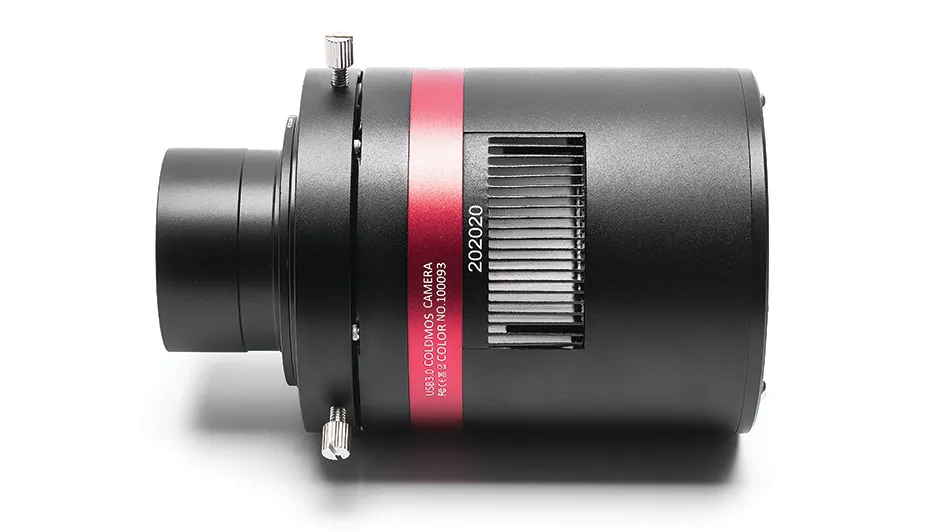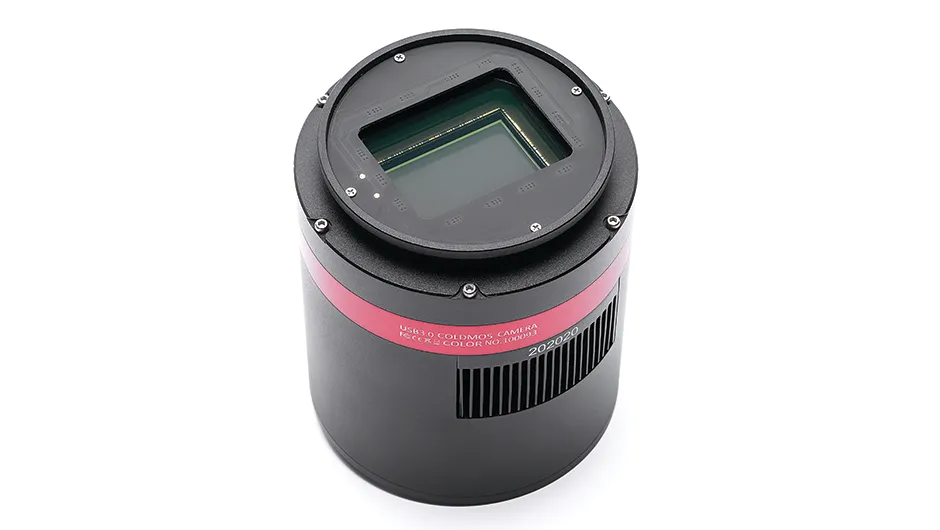Price: £4199.00
Weight: 788g
Supplier: Modern Astronomy
Telephone: 02087639953
Website: www.modernastronomy.com
QHY’s latest one-shot-colour camera, the QHY367C, is a high-resolution CMOS device capable of Solar System imaging but primarily intended for deep-sky astrophotography.
The camera uses Sony’s IMX094, one of the highest-resolution full frame (36x24mm) colour sensors available, to create an instrument that QHY dubs a ‘COLDMOS’.
The sensor is cooled by a two-stage TEC (Peltier cooling system), which provides cooling of up to 35º below the ambient temperature.
This results in low noise and a huge 14 stops of dynamic range.
Both the sensor glass and the glass for the optical window have anti-dew heating, which works exceptionally well and is particularly useful when humidity is high.
The resulting RAW file size of an individual exposure is almost 71MB, which means the camera’s USB 3.0 connection is a welcome one (a USB 3.0 cable is included), providing extremely short download times; in our case, quicker than two seconds for each full frame capture.
The 128MB DDRII image buffer acts as a cache to insure against frame loss, especially useful when shooting videos for planetary imaging.
Of course, this all means you need a powerful computer to process such large files, and one with a USB 3.0 port.
The QHY367C uses a rolling shutter design, allowing exposures as short as 60 microseconds and as long as 60 minutes.
It is capable of recording 3.2 frames per second at full resolution.
Reduce the resolution by selecting a ‘region of interest’ and you can increase the frame rate up to 83 frames per second.

Optional streaming
There is no physical manual in the box, nor any software; both are available as downloads from QHY’s website.
QHY provides both EZCap and SharpCap for camera control and image capture, as well as the necessary drivers.
ASCOM drivers are available if you want to connect the camera to other capture software, such as MaxIm DL or Sequence Generator Pro.
SharpCap can be used to enable a live video feed from the camera for capture or even for live broadcast.
The live broadcast feature may be useful for members of astronomy societies who want to share the views through their scope either live or as a webcast.
The camera is supplied with an M54 to 2-inch adaptor and an angle adjustment ring. Other adaptors will be available, including one to fit Canon or Nikon lenses for wide field views.
A 2-inch infrared-cut filter is recommended for planetary work; it was not available to us at the time of the review, but can be supplied as an optional extra.
The QHY367C is simple to use. Attach it to a 2-inch drawtube, then connect a 12V power supply and the USB 3.0 cable.
These are the only two ports on the camera – there is no guide port, so an external guide system is required for longer exposures.
After fixing it to our own 4.5-inch reflector, we selected M13 in Hercules as our first target and quickly found that our regular flattener/reducer produced serious vignetting.
It did not provide a large enough image circle to cover such a large chip.
Once removed, the remaining vignetting was easily dealt with by calibrating with flat frames.
Without the reducer, the scope was working at f/7, so we were surprised that a two-minute exposure seemed to be longer than required.
Cutting the exposure time to one minute we took 24 images of M13.
Our cropped frame of the final stacked image – showing only 10 per cent of the original frame area – showed superb detail, including the propeller feature.
Encouraged by this, we moved to the Iris Nebula in Cepheus and captured 30 two-minute exposures.
Although somewhat noisy (more frames would be needed to clean this up) the result was surprising in that it even revealed some of the dust surrounding the nebula.
QHY has, with the 367C, produced an outstanding and versatile one-shot-colour camera that pushes the boundaries of definition and sensitivity for deep space astrophotography.

Sony IMX094 chip
The full frame Sony IMX094 chip has an impressive resolution of 36.4 megapixels.
It measures 36x24mm, providing a 7,376x4,938 pixel array where each pixel is 4.88x4.88µm.
Extremely low noise can be achieved when the sensor is cooled by the two-stage TEC (Peltier cooling system).
Image captures can be ‘binned’ at 2x2 to further increase sensitivity.
One thing to bear in mind is its large diagonal (43mm).
You need to ensure that the image circle provided by your telescope provides adequate coverage, particularly if you are using a flattener/reducer, otherwise vignetting may occur.
Many telescopes are available that provide a large enough image circle so check when buying this camera that your intended scope and field flattener/reducer (if you use one) provide a large enough light cone.
Peltier cooling
The two-stage Peltier cooling system can reduce the operating temperature to 35º below the ambient temperature, providing a huge reduction in noise.
The ambient temperature at time of testing was 14°C and a steady temperature of –15°C was easily achieved after five minutes.
Anti-glare coatings
There are anti-reflection coatings on both sides of the optical window over the sensor, and this helps prevent star haloes.
Note that the window does not have an infrared-cut coating, so a separate 2-inch screw-in filter is recommended for Solar System imaging.
It is not required for deep-sky imaging.
Threaded power supply
The threaded connector and provided cables prevent accidental power disconnections, which can especially occur with unthreaded connectors when slewing.
Disconnections can be problematic as the cooling system shuts down and needs to be re-enabled.
A 12V power supply is not included.
USB 3.0 connection
The large file size and high frame rates that can be generated by this camera require a high-speed connection to download images as fast as possible.
This is particularly true when capturing video for lunar or planetary imaging and for the ‘live broadcast’ capabilities of the camera.
A USB 3.0 cable is provided.
Telescope connection & adjustment ring
The M54 to 2-inch screw-threaded adaptor/nosepiece allows the camera to be easily inserted into a 2-inch focuser.
There is an M48 thread on the nosepiece so you can attach a filter.
The angle adjustment ring allows you to get the sensor precisely square to the image plane.
This review originally appeared in the September 2017 issue of BBC Sky at Night Magazine.
